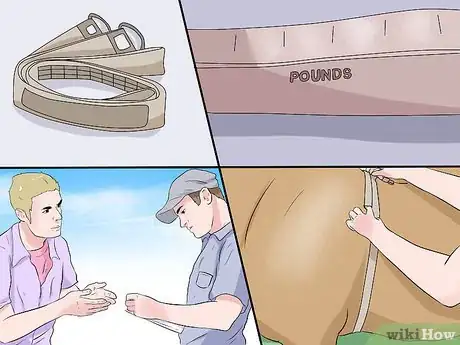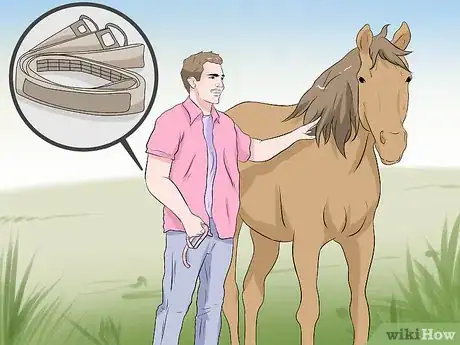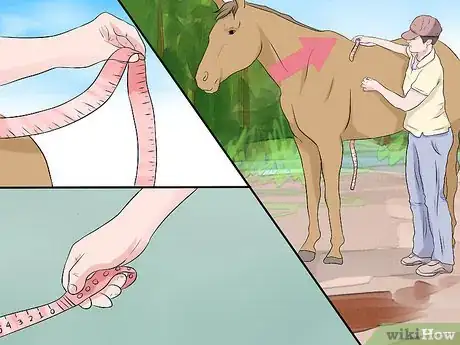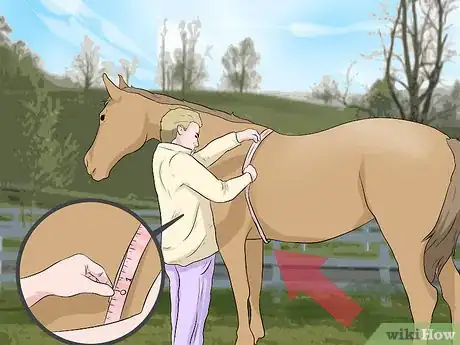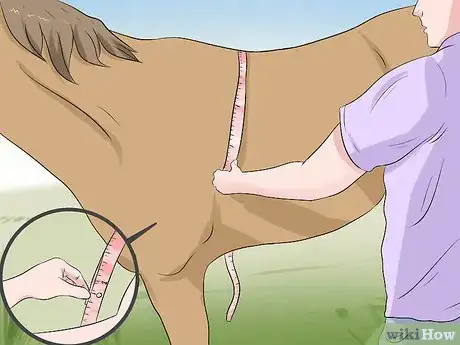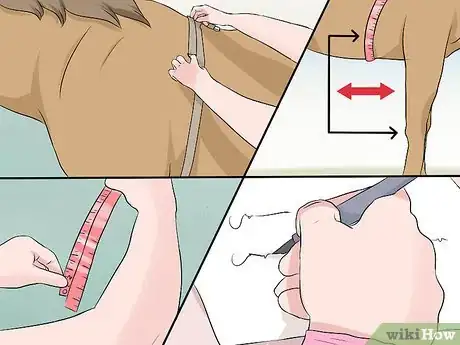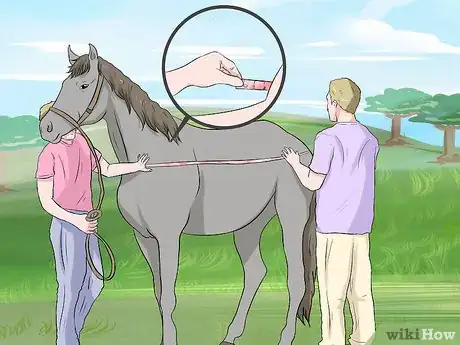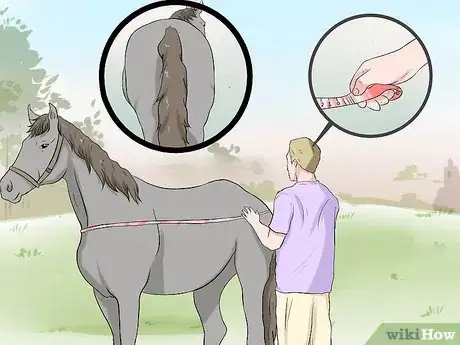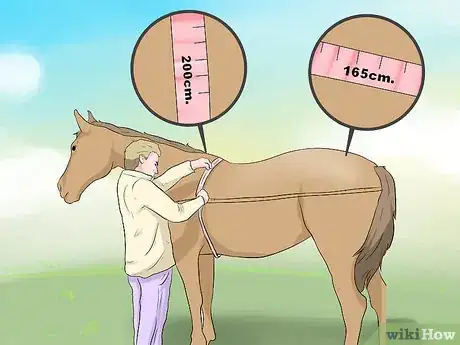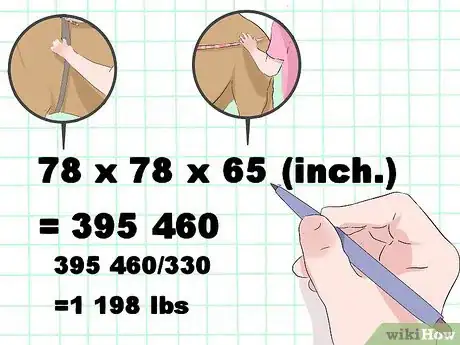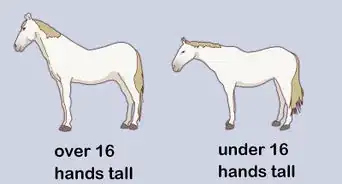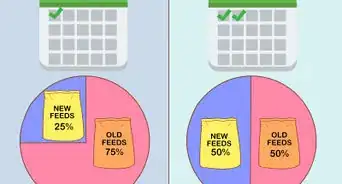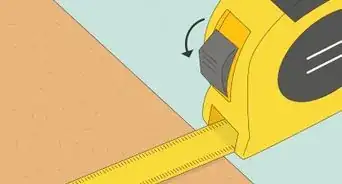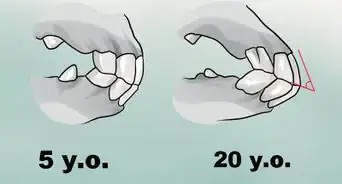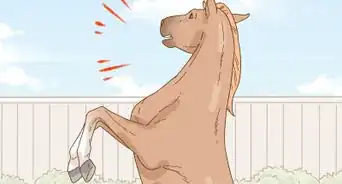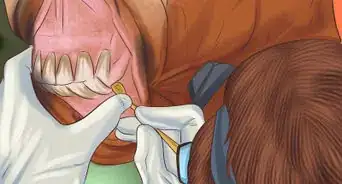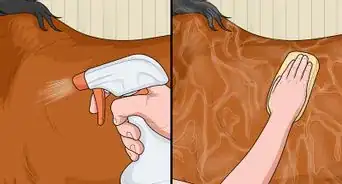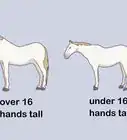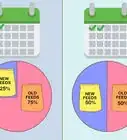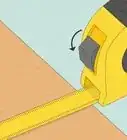This article was co-authored by Pippa Elliott, MRCVS. Dr. Elliott, BVMS, MRCVS is a veterinarian with over 30 years of experience in veterinary surgery and companion animal practice. She graduated from the University of Glasgow in 1987 with a degree in veterinary medicine and surgery. She has worked at the same animal clinic in her hometown for over 20 years.
This article has been viewed 141,944 times.
Knowing your horse's weight will help you determine his nutritional requirements and proper dosage for dewormers and other medications. If you don't have access to a large scale, it's easy to use a tape measure to weigh your horse. Use a tape marked especially for the purposes of weighing your horse, or an ordinary tape measure.
Steps
Using a Weight Tape
-
1Ask your feed dealer for a weight tape. A weight tape is marked in pounds instead of inches. It's made of soft, strong cloth. A weight tape estimates a horse's weight by measuring it's heart girth. The weight tape is best used for occasions where you don't need an exact weight.[1]
- You can buy a weight tape from catalogs, but many feed dealers give them away for free. Tapes are an easy way to provide advertising for the dealer.
- Weight tapes are sometimes printed on both sides. One side will list pounds, the other side will list the number of "hands". This side isn't necessary for the purpose of weighing a horse.
- A weight tape provides a less accurate weight estimate than an ordinary tape measure. It may be as much as 100-200 pounds away from the horse's actual weight. If you need a more precise measurement, e.g. for a strong dewormer, consider using a tape measure instead.
-
2Stand your horse on level ground. Make sure the horse's head is relaxed, and that you have your weight tape with you.[2]
- If the horse's head isn't relaxed, talk to him gently and wait until he relaxes. It's important that his head relax to get a more accurate weight.
- You should also be relaxed. Take several deep breaths, and center yourself before starting to measure the horse.
- Try to do this on a calm day, without much wind. Wind will make your task more difficult.
Advertisement -
3Stand on the horse's left side. Hold the tape end marked zero. Drape the weigh tape over the horse's back just behind his withers, or the small hump at the base of the neck.[3]
- If the tape gets twisted, your reading won't be accurate. Be careful to smooth it down with your hands if it twists.
- If your horse is young or easily spooked, having this tape draped across his back may provoke a nervous reaction. Stay calm, and stop moving the tape until the horse calms.
-
4Reach under your horse's belly with your free hand and pull it gently towards you. You want the tape to be snug but not tight. Hold the tape beside the end of the tape in your hand (marked "zero").[4]
- It's usually easier to hold the "zero" end of the tape still next to the horse's body while you pull the measuring tape up over it.
- A helper can make this task a lot easier, especially if your horse is easily spooked.
-
5Read the number on the tape where it meets the "zero" end. This is your horse's weight. For best results, repeat this process several times. Because your horse's body expands and contracts as he breathes, your measurement will be slightly different each time. [5]
- Make sure your thumbs or fingers aren't beneath the tape when you read the measurement.
- Weigh your horses regularly, to ensure best nutrition and health.
Using a Measuring Tape
-
1Measure your horse's heart girth. Drape a standard soft measuring tape across your horse's back, as in the step above. Hold the tape at the "zero" end.[6]
- The tape can be measured in feet and inches, or it can be measured in centimeters. The marking will affect the calculation that you do later in the process of determining your horse's weight.
- This is best done out of the wind. Wind can cause the tape measure to flap and twist, making it harder to manage. A flapping tape can also spook a horse, resulting in a difficult measuring session.
-
2Pull the tape gently beneath the horse's belly. The tape should be a few inches behind the horse's front legs. Raise the tape to meet the tape held in your other hand, and read the measurement where the "zero" end of the tape meets the other side. Write the measurement down on a paper.[7]
- You may notice that the tape runs at an angle from slightly behind the horse's front legs to the base of the withers. This is how it should be.
- To make sure you have the most accurate measurement, repeat the measuring process.
-
3Measure your horse's length. You will need a second person to help you hold the measuring tape. Position the other person on the right side of the horse. This person should hold the "zero" end of the tape measure at the point of the horse's shoulder.[8]
- Don't stand too close to the horse's hind quarters, or he's likely to be spooked.
- Make sure the second person is attentive and quiet.
-
4Walk beside the horse holding the measuring tape. Pull the tape taut once you reach the point of the horse's buttock or crease.
- Make sure the tape isn't twisted as you pull it, or this may affect the accuracy of your measurement.
- The second person might hold your notebook and pen for marking your measurements, leaving your hands free for holding the tape.
-
5Notice if your measurement is in inches (English) or centimeters (metric). You now have your horse's heart girth and length written on a paper. For example, your horse's heart girth might be 78 inches, and his length 65 inches. If you've measured in centimeters, heart girth might be 200 cm, length 165 cm. You'll need these to calculate your horse's weight.[9]
- If your measurements are in centimeters, write down the number 11,990. Your weight will be in kilograms.
- If your measurements are in inches, write down the number 330. Your weight will be in pounds.
-
6Multiply the measured heart girth x heart girth x length. For example, if heart girth were 78 and length were 65 inches, multiply 78 x 78 x 65. You should arrive at the figure 395,460. When you have a total from the multiplication, divide this number by the number shown above.[10]
- If you're measuring in centimeters, divide your total by 11,990. The result will be your horse's weight, in kilograms. Find the weight of a horse with heart girth 200 cm, length 165 cm by using this equation: 200 x 200 x 165 = 6,600,000. Divided by 11,990, the final number would be 550. That is your horse's weight.
- If you're measuring in inches, divide your total by 330. The result will be your horse's weight, in pounds. So, using the example above, 78 x 78 x 65 = 395,460. Divided by 330, the final number would be 1,198. That's your horse's weight.
Warnings
- The weight estimate for your horse found by measuring is a very approximate weight. It may not be appropriate way to estimate weight for all horses. It's designed for horses with standard bodies, and isn't used for ponies, draft horses, or long-bodied horses⧼thumbs_response⧽
- If you need more precise estimate of your horse's body weight, i.e. for determining proper dosage of strong medicines, you'll need to weigh your horse on a scale.⧼thumbs_response⧽
References
- ↑ http://www.understanding-horse-nutrition.com/weight-tape.html
- ↑ http://www.understanding-horse-nutrition.com/weight-tape.html
- ↑ http://www.understanding-horse-nutrition.com/weight-tape.html
- ↑ http://www.understanding-horse-nutrition.com/weight-tape.html
- ↑ http://www.understanding-horse-nutrition.com/weight-tape.html
- ↑ http://www.thehorse.com/articles/31852/adult-horse-weight-calculator
- ↑ http://www.thehorse.com/articles/31852/adult-horse-weight-calculator
- ↑ http://www.cowboyway.com/HowTo/HorseWeight.htm
- ↑ http://www.thehorse.com/articles/24740/determining-horses-body-weight-and-ideal-condition
About This Article
To use a tape to weigh a horse, stand your horse on level ground and make sure that its head is relaxed to get a more accurate weight. Once your horse is at ease, stand on its left side and drape the tape over its back just behind its withers, or the small hump at the base of the neck. Then, reach under your horse’s belly with your free hand and pull the tape gently towards you. Read and record the number you see, which is an approximation of your horse’s weight. For best results, repeat this process a few times to make sure you’ve been as accurate as possible. To learn how to use a measuring tape to weigh your horse, keep reading!
